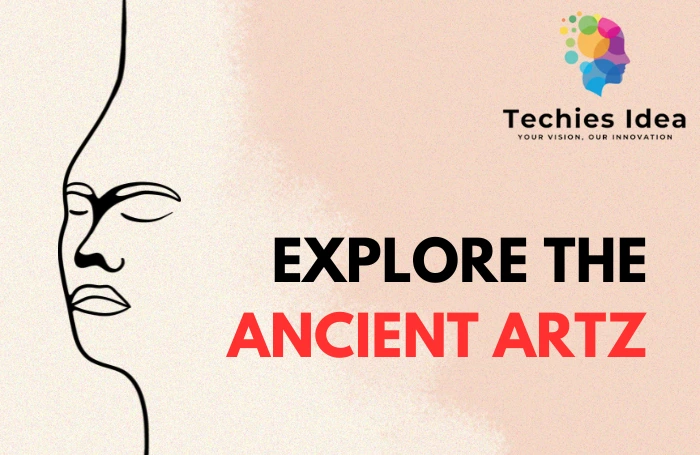Ancient Artz reflects our history and past civilization. It allows us to look up the mind and life of civilization long gone. Ancient artz has an important place in history. The creation of artwork is not just a decoration piece but also has deep meaning, each piece is a symbol of belief and culture.
What is an Ancient Artz?
Ancient Artz represents the artistic creation of early human society. The oldest example of art comes from the prehistoric time. Early human expressed their emotion through rock carving and cave painting. These artworks are used to communicate or tell stories about their daily life.
One of the famous examples of ancient art is the Lascaux caves in France. The painting was found nearly 17000 years ago and depicts large animals such as horse bison and deer. They used natural pigment to create a masterpiece. The art not only shows their surrounding but also establishes connect with nature.
Origin of the Ancient artz
The Ancient Artz story begins with the dawn of human consciousness. The ancestors, driven by innate expression of themselves and marks on cave walls, crafted a figure of bone and stone. These primitive yet profound creations mark the birth of symbolism and abstraction in human culture.
Milestones of the Early Art History
- Cave paintings (c. 40,000 BCE)
- Venus figurines (c. 35,000-40,000 BCE)
- Megalithic structures (c. 3000 BCE)
Ancient Artz in various cultures
Ancient artz mainly depends on the region and culture. For example, Egyptian art is inspired by religion. Egyptians believed in an afterlife and their artwork was much more focused on ensuring a successful journey to the next world. They created tomb paintings and sculptures that indicate God pharaohs and routine activities. The art is well known for its use of cuneal writing which provides image and written detail.
In Ancient Greece, art revolves around the human experience. The Greeks celebrated the human form and much of their artwork idealized the human body in the form of sculptures and pottery. It is also famous for the portrayal of mythological scenes that depend on gods and heroes in action.
Read: Wave_of_Happy_ : A Digital Joyride For Online Audience
Chinese art is linked with philosophy and spirituality. The Chinese artist is famous for his calligraphy landscape painting and bronze casting. Their art often reflects balance and melodies between nature. The Ancient Chinese express their connection to the cosmos and the world.
The Americans also have a rich artistic heritage. With their intricate carving, they have a historical record. Their famous artwork is sun stone and generally believe in cosmology. Mayan art is famous for its complex writing system. They are found at a sites like Copan and Tikal. The Myan artist was also great at creating jade jewelry and colorful ceramic vessels.
The symbols important of the Ancient Artz
Symbols play an important role in Ancient artz. Artist use images and symbols in their art which convey deep meaning. For example, the Egyptian lotus flower symbolizes creation and rebirth. Ancient Greek art owls often represent wisdom and are associated with the goddess Athena.
The symbol is not used for a decoration purpose but serves a specific meaning. They used the symbol as a form of communication helping to convey complex religious and philosophical ideas. For many cultures, art is related to the divine. It was a means of telling stories and passing tradition from generation to generation.
Material and technique
Ancient artwork available in a variety of materials depending on what was available, they commonly used materials which is easily available such as stone, wood, clay, and metal. Egypt artists used stone to create sculptures while in Greece marble was favored for creating lifelike statues.
The Ancient Egyptians used a method called fresco painting where pigmentation was applied to wet plaster. This technique of color lasted for a thousand years.
In Mesopotamia artist were known for their clay tablet which they carved with intricate designs and cuneiform script.
Chinese artists developed porcelain and created delicate pottery and vases. They also mastered the art of bronze casting to create stunning statues and ritual vessels. Each culture has its unique technique, but the motto was the same.
Common material in ancient art
- Stone
- Metal
- Clay
- Wood
- Textile
- Pigment
Stone carving
Stone carving is a significant technique in many ancient cultures. The Greeks, Romans, and Egyptians are excellent at working with hard stones such as granite and marble. They used different tools, including bronze chisels, hammers, and abrasives like sand for polishing.
Metal working
Metalworking techniques varied across cultures and periods. The lost wax casting method, used for creating intricate bronze sculptures, was known to the Ancient Egyptians, Greeks, and Chinese. This process involved creating a wax model, encasing it in clay, melting out the wax, and pouring molten metal into the resulting cavity.
Gold working is sophisticated in many Ancient cultures, the Egyptians developed a technique for beating gold into a thin sheet for gilding, whereas Etruscan used the art of granulation, attaching tiny gold beads to create intricate patterns.
Ceramics
Pottery was one of the earliest forms of the Ancient Artz. The potter wheel invented around 3500 BCE in Mesopotamia revolutionized ceramic production. They developed a black figure and red figure technique, which allowed them to create intricate narrative scenes on vases.
Painting
The fresco technique used in Ancient Roman wall painting, involved applying pigment to wet plaster, creating durable and vivid images. It allows to creation of a large-scale mural that is long up to a century.
Conservation challenges
Preventing an artwork is challenging. Many materials are fragile and susceptible to damage from light, humidity, and pollution. Stone painting was affected by vandalism whereas textiles and paintings faded over time.
Conclusion
Ancient Artz establishes a connection between the modern world and the distant past. By studying Ancient artz we gain valuable insight into shared experiences, beliefs, and aspirations that humanity has across the world.
FAQ
1) What is the oldest piece of Ancient Artz?
The oldest piece of art is a 40,000-year-old cave painting of a wild pig found in Indonesia. Abstract patterns and handprints date back to various cave sites around the world.
2) How Ancient Artz is used in daily existence?
Ancient Artz served multiple purposes:
- Religious and spiritual practices
- Commemorating important event
- Storytelling and education
- Display wealth and status
3) Which technique was used in Ancient Artz?
There are various techniques used in ancient artz such as Cave painting, metalwork, mirror work, and ceramic.
4) Why Ancient Artz is important?
It offers insight into the beliefs, values, and daily lives of early society.
Yashik Patel is a Google Certified, Digital Marketing and professional Blogger. He has 7+ years of experience in SEO, SEM, and ORM (Online Reputation Management) field.


